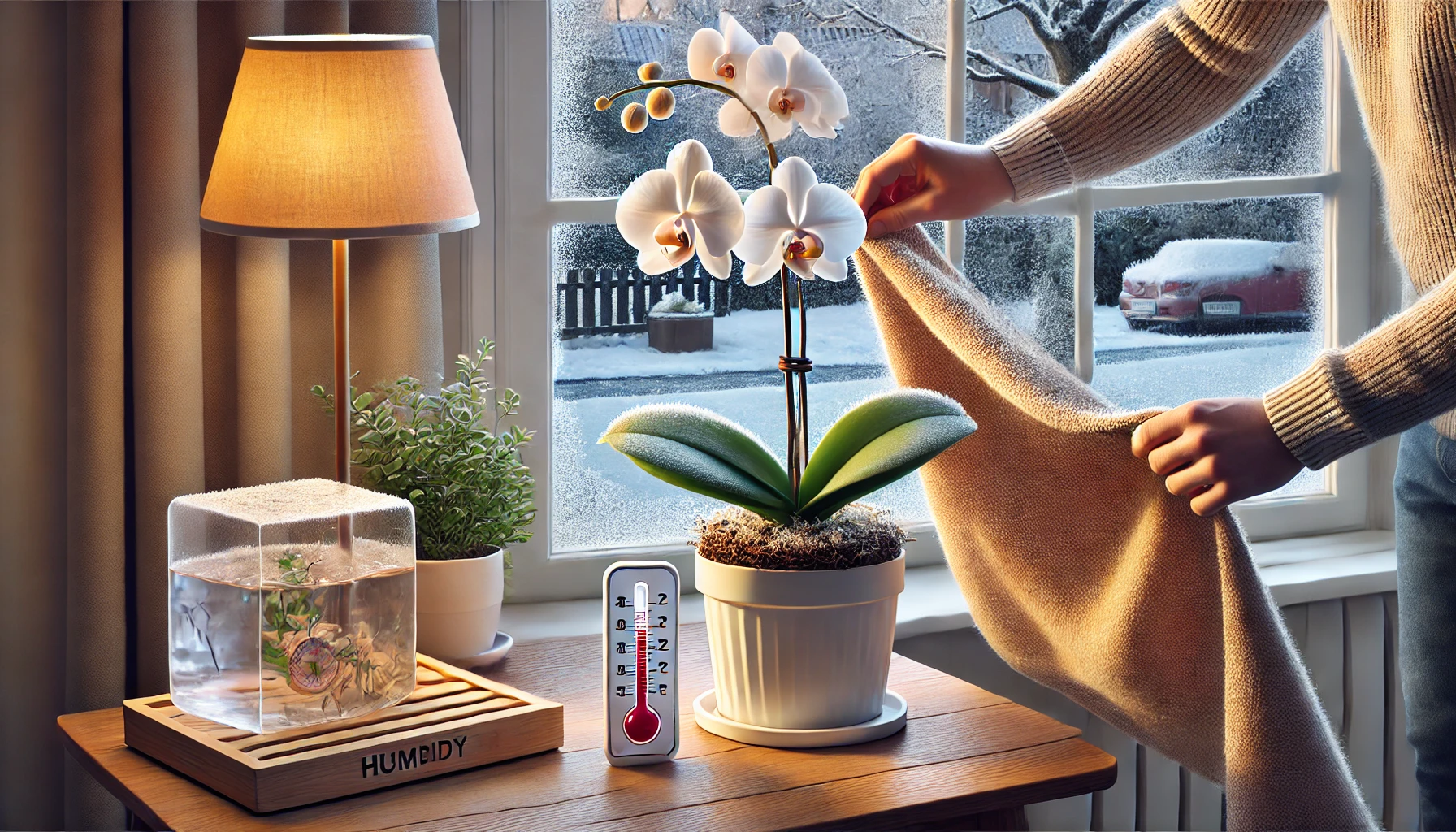Orchids are tropical plants that thrive in warm, humid environments, but when temperatures drop, they can struggle to survive. Exposure to cold weather can cause leaf damage, slowed growth, and even plant death if not managed properly. To keep your orchid healthy year-round, it’s essential to protect it from sudden temperature changes and cold drafts.
🌡 Why Cold Temperatures Are Harmful to Orchids
Orchids naturally grow in warm, stable climates, often attached to trees where they receive consistent air circulation, moisture, and indirect sunlight. When exposed to cold air, frost, or temperature fluctuations, orchids can go into shock, leading to bud drop, root damage, and weakened leaves.
✔ Ideal Orchid Temperature Range:
- Daytime: 65–75°F (18–24°C)
- Nighttime: 55–65°F (13–18°C)
❌ When temperatures drop below 50°F (10°C), orchids start to suffer and may show signs of stress.
💡 If you live in a cold climate, taking extra precautions is necessary to keep your orchid thriving.
🛑 Signs of Cold Damage in Orchids
Orchids often show visible signs of stress when exposed to cold temperatures. The sooner you recognize these warning signs, the better chance you have to save your plant.
❌ Cold-Damaged Orchid Symptoms:
- Dark, mushy, or blackened leaves (frost damage)
- Wrinkled or drooping leaves (temperature shock)
- Bud blast (flower buds drying and falling off before blooming)
- Slow or no new root growth (hibernation due to cold exposure)
- Yellowing or browning leaf tips (temperature stress)
💡 If you notice any of these symptoms, take immediate action to prevent further damage!
🏡 How to Protect Orchids Indoors During Cold Weather
If you grow orchids indoors, they are still at risk from cold drafts, sudden temperature drops, and dry winter air. Here’s how to keep them safe:
✔ Keep orchids away from windows and doors where cold air can seep in.
✔ Use a humidity tray or room humidifier to maintain 50–70% humidity, preventing dehydration.
✔ Place orchids on an insulated surface (not directly on cold windowsills or stone countertops).
✔ Avoid positioning orchids near heaters, radiators, or vents, as these can create dry, hot air that stresses the plant.
✔ Use sheer curtains to insulate windows while still allowing light to reach the plant.
✔ Monitor room temperature with a thermometer, ensuring it stays within the safe range.
💡 If your house gets too cold at night, consider moving your orchid to a warmer room before bedtime.
🌿 How to Protect Orchids Outdoors from Cold Weather
If you grow orchids outdoors or on a balcony, they are more vulnerable to frost and sudden temperature changes. To protect them:
✔ Bring orchids inside when temperatures drop below 55°F (13°C).
✔ If you can’t bring them inside, cover them with a frost cloth or light blanket to retain warmth.
✔ Place orchids near a sheltered wall or in a greenhouse to reduce exposure to wind and cold air.
✔ Avoid watering at night in cold conditions—moisture on the leaves can freeze, causing frost damage.
✔ Use mulch or sphagnum moss around the base of outdoor orchids to insulate roots.
💡 If orchids must stay outside, position them under an overhang or shaded area to protect them from frost.
🔥 How to Revive a Cold-Damaged Orchid
If your orchid has been exposed to cold temperatures, don’t panic—there are steps you can take to help it recover.
🛠 Steps to Save a Cold-Damaged Orchid:
1️⃣ Move it to a warm location immediately, avoiding direct sunlight or heat sources.
2️⃣ Inspect the leaves and roots for damage—trim any blackened or mushy areas using sterilized scissors.
3️⃣ Increase humidity using a humidity tray or by placing the orchid in a warm, humid bathroom for a few hours.
4️⃣ Water sparingly—only when the roots turn silvery-white, as overwatering a stressed orchid can cause rot.
5️⃣ Be patient—orchids take time to recover from cold stress. Focus on stable temperatures and gentle care.
🚫 Common Mistakes That Can Make Cold Damage Worse
❌ Moving an orchid directly to a hot environment—sudden temperature changes can cause more stress.
❌ Overwatering a cold-damaged orchid—damaged roots absorb less water, increasing the risk of rot.
❌ Fertilizing too soon—wait until the orchid starts producing new roots or leaves before resuming feeding.
❌ Leaving a cold-damaged spike intact—trim flower spikes if they show blackened or dead tissue.
🌞 How to Encourage Blooming After Winter Stress
Once winter is over and temperatures stabilize, you can help your orchid regain strength and prepare for blooming.
✔ Gradually expose the orchid to natural light, increasing brightness slowly.
✔ Increase watering slightly, but only when the roots appear dry.
✔ Switch to a bloom-boosting fertilizer (10-30-20) when new spikes start forming.
✔ Maintain a steady nighttime temperature drop of 10°F (5°C) to encourage flower production.
🛡 Final Tips for Keeping Orchids Safe from Cold Weather
✔ Keep orchids in a temperature-controlled space, avoiding sudden drops.
✔ Use a humidity tray or humidifier to counteract dry winter air.
✔ Protect outdoor orchids with covers, mulch, or by moving them inside when frost is expected.
✔ Watch for signs of cold damage and take immediate action to prevent further stress.
✔ Be patient—cold-damaged orchids can recover with time and proper care.
By following these steps, you can keep your orchids healthy, strong, and ready to bloom again—no matter how cold it gets outside! 🌸✨
